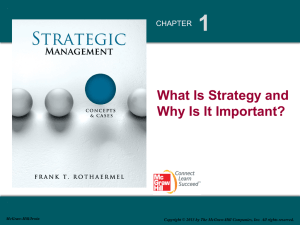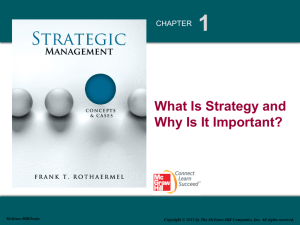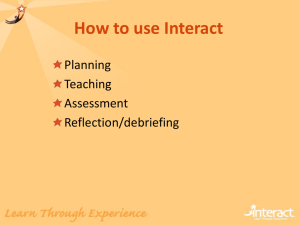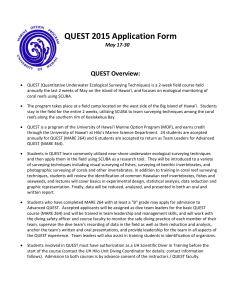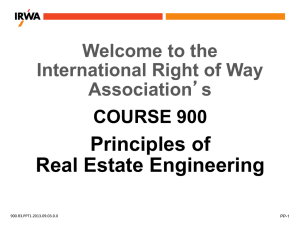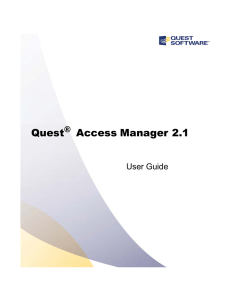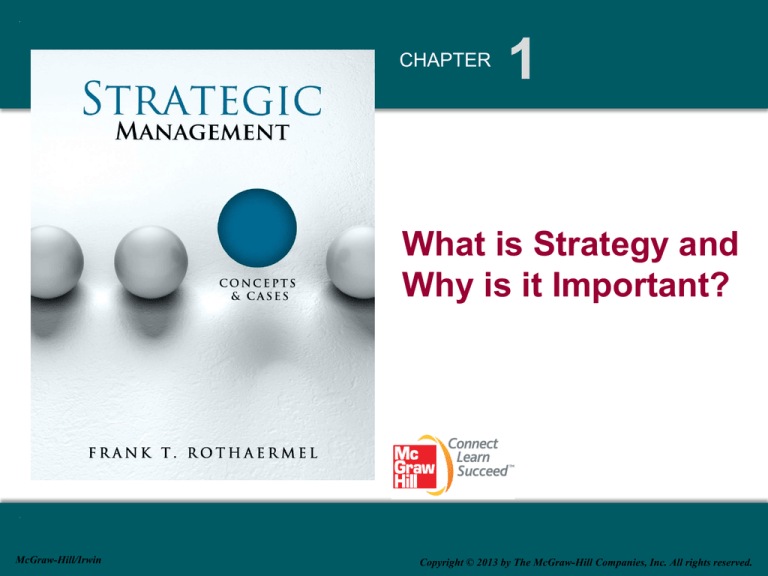
CHAPTER
1
What is Strategy and
Why is it Important?
McGraw-Hill/Irwin
Copyright © 2013 by The McGraw-Hill Companies, Inc. All rights reserved.
The Wisdom of Choice
•
“To try and fail is at least to learn; to fail to try is to
suffer the inestimable loss of what might have been.”
– Chester Barnard
(former CEO of New Jersey Bell Telephone)
• The Functions of the Executive
Part 1 Strategy Analysis
LO 1-1 Define competitive advantage, sustainable competitive
advantage, competitive disadvantage, and competitive parity.
LO 1-2 Define strategy and explain its role in a firm’s quest for
competitive advantage.
LO 1-3 Explain the role of firm effects and industry effects in determining
firm performance.
LO 1-4 Describe the role of corporate, business, and functional managers
in strategy formulation and implementation.
LO 1-5 Outline how business models put strategy into action.
LO 1-6 Describe and assess the opportunities and challenges managers
face in the 21st century.
LO 1-7 Critically evaluate the role that different stakeholders play in the
firm’s quest for competitive advantage.
1–4
ChapterCase 1
The Premature Death of a Google Forerunner at Microsoft
• Google founded in 1998
Two graduate students at Stanford –
Sergey
Brin and Larry Page
PageRank algorithm a clear improvement
Today, it is world’s leading online search/advertising firm
• Microsoft bought LinkExchange in 1998
Keywords product for search engines; but shut down in 2000
• Microsoft considered buying Overture Services in 2003
Gates and Ballmer passed on the deal
Yahoo buys Overture -- an innovator in internet
services/advertising -- for its own search product
for $1.6 billion
• Microsoft launches its own search in 2009
Bing now strategically partnered with Yahoo
1–5
What Strategy is: Gaining and Sustaining
Competitive Advantage
• What is Competitive Advantage?
Superior performance relative to competitors
Examples: Google, Pfizer’s Lipitor (patent
protection to 2010)
• What is Sustainable Competitive Advantage?
Sustainable competitive advantage occurs when a firm
implements a value-creating strategy of which other
companies are unable to duplicate the benefits or find
it too costly to imitate.
An important basis for sustainable competitive advantage
is the development of resources and capabilities.
1–6
What Strategy is: Gaining and Sustaining
Competitive Advantage
• What is Strategy?
Goal-directed actions to gain & sustain competitive advantage
It is not a zero-sum game
Win – win scenarios – co-opetition (i.e., collaborative
efforts among competitors for mutual gain)
Requires trade-offs for strategic positioning
(low cost) JCPenney vs. (upscale) Neiman Marcus
(low cost) Southwest Airlines vs. (stuck in the middle) Delta Song
Definitions of Strategy
• "The term 'strategy' is intended to focus on the
interdependence of the adversaries’ decisions and
on their expectations about each other’s behavior.”
(Thomas Schelling The Strategy of Conflict)
• “Strategy can be defined as the determination of the basic
long-term goals and objectives of an enterprise, and the
adoption of courses of action and the allocation of
resources necessary for carrying out those goals.”
(Alfred D. Chandler Strategy and Structure)
• Strategy is: “The pattern or plan that integrates an
organization’s major goals, policies, and action sequences
into a cohesive whole. A well formulated strategy helps to
marshal and allocate an organization’s resources into a
unique and viable posture based on its relative internal
competencies and shortcomings, anticipated changes in
the environment, and contingent moves by intelligent
opponents.” (James Brian Quinn, Logical Incrementalism)
1–8
Strategy as a Theory of How to Compete
• Provides a Manager's Roadmap
The strategic management process is a cycle of
analysis, formulation, implementation, and feedback.
Apple Newton flops in 1993
PalmPilot (Jeff Hawkins) learned from Apple
Newton’s mistakes
iPhone a huge success in 2009
Wal-mart' (Sam Walton’s) assumptions about low costs,
low prices, and high volume to drive profitability
Auto industry differences between U.S. and Japan
Palm Video
EXHIBIT 1.2
Definition:
What is Strategy?
Strategy is the quest to create, capture and
sustain competitive advantage.
• It is the managers’ theories/maps about how to gain and
sustain competitive advantage.
• It is about being different from your rivals.
• It is about creating value while containing cost.
• It is about deciding what to do, and what not to do.
• It combines a set of activities to stake out a unique position.
• It has alternatives, consequences, and choices involving significant
resources, typically made under some level of uncertainty.
• It requires long-term commitments that are not easily reversible.
1–10
Key Drivers of Value Creation and
Sustainable Competitive Advantage
• Generating economic value can be accomplished
through:
REVENUE drivers
COST drivers
RISK drivers
1–11
Value and Cost Drivers
Figure 2.5
LO 1-1 Define competitive advantage, sustainable competitive advantage,
competitive disadvantage, and competitive parity.
LO 1-2 Define strategy and explain its role in a firm’s quest for competitive
advantage.
LO 1-3 Explain the role of firm effects and industry effects in
determining firm performance.
LO 1-4 Describe the role of corporate, business, and functional
managers in strategy formulation and implementation.
LO 1-5 Outline how business models put strategy into action.
LO 1-6 Describe and assess the opportunities and challenges
managers face in the 21st century.
LO 1-7 Critically evaluate the role that different stakeholders play in the
firm’s quest for competitive advantage.
1–13
EXHIBIT 1.1
Industry, Firm, and Other Effects Explaining Superior Firm Performance
Industry vs. Firm Effects in Performance
Astute managers create superior performance
Making important trade-offs
- Toyota’s lean manufacturing
1–14
S o u rc e s o f S u p e rio r P ro fita b ility
IN D U S T R Y
A T T R A C T IV E N E S S
R A T E O F P R O F IT
ABOVE THE
C O M P E T IT IV E
LEVEL
How do we
m ake
m oney?
W h ic h
b u s in e s s e s
s h o u ld w e b e
in ?
CORPORATE
STRATEGY
C O M P E T IT IV E
ADVANTAGE
H o w s h o u ld
w e c o m p e te ?
B U S IN E S S
STRATEGY
15
Strategy Across the Levels
• Where to Compete?
Should GE move more
aggressively into the
health care industry?
• How to Compete?
Should GE jet engines
• CORPORATE
STRATEGY
• BUSINESS
STRATEGY
have better fuel efficiency
than Rolls Royce?
• How to Implement?
Should GE human
resources recruit more
science graduates?
• FUNCTIONAL
STRATEGY
1–16
Levels of Strategy
• Corporate Level: Typically involves decision-making by
the top management team that includes the CEO, senior
executives, the board of directors, and the corporate staff.
Decisions include vertical integration, diversification, strategic
alliances, acquisitions, new ventures, and restructuring.
• Business Level: Includes the strategic choice of generic
strategy (cost leadership, differentiation, focus) and the
benefits and costs of first-mover advantages. Often an
enterprise participating in multiple businesses will have
different business strategies.
• Functional Level: Typically directed at improving the
effectiveness of functional operations within a company, such
as manufacturing, materials management, human resources,
marketing, R&D and operations management.
1–17
EXHIBIT 1.3
Strategy Formulation and Implementation Across Levels:
Corporate, Business, and Functional Strategy
Business Models
• Putting Strategy into Action
"Razor-blade model" (e.g., laser printers)
Subscription model (free cell phone
along with wireless plan)
• How is the firm going to make money to
continue operations?
• What’s happening now between Microsoft
and Google?
Business models in opposite directions
1–19
EXHIBIT 1.4
Competing Business Models: Google vs. Microsoft
Multi-point Competition
Microsoft
Operating
Systems
Software
Apps
Online
Search
Google
1–20
Strategy in the 21st Century
• Accelerating Technological Change:
84 years for half of U.S. families to own a car;
28 years for half to own a TV;
19 years for the PC to reach 50% ownership;
6 years for an MP3 player.
1–21
EXHIBIT 1.5
Accelerating Speed of Technological Change
1–22
Strategy in the 21st Century
• A Truly Global World
BRIC countries have 40% of earth’s population
Brazil, Russia, India, and China
IBM has less than 30% of employees in the U.S.
“Bottom of the pyramid” business opportunities
Grameen Bank in India: Microcredit
Thomas Friedman-Flat World
1–23
EXHIBIT 1.6
Geographic Sources of IBM Revenues, 2010
Is IBM still a “U.S. company” ?
1–24
Strategy in the 21st Century
• Future Industries
Health Care
In
the U.S., over 16% of GDP and still growing
Green Economy
Potentially
large growth in energy efficiency
and technologies (e.g., solar panels)
WEB 2.0
Interactivity
and using collective intelligence on the
Internet. Subject to "network externalities"
1–25
STRATEGY HIGHLIGHT 1.1
Threadless: Leveraging Crowdsourcing
to Design Cool T-Shirts
• Online apparel company: Threadless
Started in 2000 with $1,000 by 2 students –
Jake Nickell and Jacob Dehart
“Prosumers” – a hybrid supplier/customer
Shirt designs are submitted by the community
Designs are voted on by the online community
– Only winning designs are produced & sold
– “Crowdsourcing”: volunteers for tasks
Threadless Interview
1–26
LO 1-1 Define competitive advantage, sustainable competitive advantage,
competitive disadvantage, and competitive parity.
LO 1-2 Define strategy and explain its role in a firm’s quest for competitive
advantage.
LO 1-3 Explain the role of firm effects and industry effects in determining
firm performance.
LO 1-4 Describe the role of corporate, business, and functional managers
in strategy formulation and implementation.
LO 1-5 Outline how business models put strategy into action.
LO 1-6 Describe and assess the opportunities and challenges managers
face in the 21st century.
LO 1-7 Critically evaluate the role that different stakeholders play in
the firm’s quest for competitive advantage.
1–27
The Manager’s Role in Balancing Expectations
• Business Roundtable:
“Balancing the shareholder’s expectations of maximum
return against other priorities is one of the fundamental
problems confronting corporate management.”
• Understanding corporate strategy means understanding the
competing value claims of multiple stakeholders.
• Stakeholders are the individuals and groups who can affect,
and are affected by, the strategic outcomes achieved and
who have enforceable claims on a firm’s performance.
EXHIBIT 1.8
Internal and External Stakeholders
1–29
O u r Le a rnin g G o a ls:
P u sh in g D o w n T h ro u g h B lo o m ’s T a xo n o m y
1 . K n o w le d g e :
re
rem
meem
mbbeerr
m
maate
teria
rial;l; kn
knoow
w te
term
rms,
s, fa
facts,
cts,
ppro
roce
cedduure
res,
s, bbaasic
sic co
connce
ceppts
ts
2 . C o m p re h e n sio n :
ggra
rasp
sp m
meeaannin
ingg;; uunnddeersta
rstanndd
fa
facts,
cts, in
inte
terp
rpre
rett ch
chaarts,
rts,
tra
trannsla
slate
te ve
verb
rbaall to
to m
maath
th
eestim
stimaate
te co
connse
seqquueennce
cess
3 . A p p lica tio n :
uuse
se
m
maate
teria
riall in
in nneew
w situ
situaatio
tionnss;;
aapppply
ly co
connce
ceppts
ts to
to re
reaall
situ
situaatio
tionns,
s, fo
follo
llow
w aa ppro
roce
cedduure
re
4 . A n a lysis:
bbre
reaakk m
maate
teria
riall
in
into
to co
com
mppoonneennts
ts &
& uunnddeersta
rstanndd
stru
structu
cture
re;; re
reco
coggnnize
ize lo
loggica
icall
fa
falla
llaccie
ies,
s, ddistin
istingguuish
ish fa
fact
ct aanndd
in
infe
fere
rennce
ce,, eeva
valu
luaate
te re
rele
leva
vanncy
cy ooff
ddaata
ta
5 . S yn th e sis:
in
inte
teggra
rate
te ppaarts
rts
to
to m
maake
ke aa nneew
ww
whhoole
le,, in
inte
teggra
rate
te
le
leaarn
rnin
ingg to
to so
solve
lve aa ppro
robble
lem
m
6 . E va lu a tio n s:
ju
juddggee lo
loggica
icall
co
connsiste
sistenncy,
cy, ju
juddggee w
whheeth
theerr
co
connclu
clusio
sionnss aare
re su
suppppoorte
rtedd bbyy
fa
facts
cts
30
Most Frequently Cited Skills of Effective Managers
• Most frequently cited skills of effective managers. This
survey is the assessment of more than 500 mid-level
and upper-level managers in about 150 organizations:
01.
Verbal communication
(especially the ability to listen and give counsel)
02.
Managing time and stress
03.
Managing individual decisions
04.
Recognizing, defining, and solving problems
05.
Motivating and influencing others
06.
Delegating
07.
Setting goals that are operational
1–31
Most Frequently Cited Skills of Effective Managers
08.
Self-awareness
09.
Team building
10.
Managing conflict
11.
Ability to give a formal presentation
12.
Patience and respect toward others
13.
Analytical abilities and technical competence
14.
Hard work and enthusiasm
15.
Skills for integrating specialized knowledge
16.
Ability to write effective reports
17.
Knowledge of business and strategic planning
18.
Tolerance and adaptability to change
1–32

